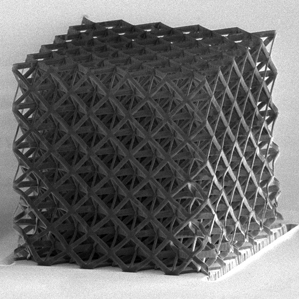A Super-Strong and Lightweight New Material
A new type of material, made up of nanoscale struts crisscrossed like the struts of a tiny Eiffel Tower, is one of the strongest and lightest substances ever made.

If researchers can figure out how to make the stuff in large quantities, it could be used as a structural material for making planes and trucks, as well as in battery electrodes.
Researchers led by Caltech materials scientist Julia Greer found that by carefully designing nanoscale struts and joints, they could make ceramics, metals, and other materials that can recover after being crushed, like a sponge. The materials are very strong and light enough to float through the air like a feather. The work is published today in the journal Science.
In conventional materials, strength, weight, and density are correlated. Ceramics, for example, are strong but also heavy, so they can’t be used as structural materials where weight is critical—for example, in the bodies of cars. And when ceramics fail, they tend to fail catastrophically, shattering like glass.
But at the nanoscale the same rules do not apply. In this size range, the structural and mechanical properties of ceramics become less tied to properties such as weight, and they can be altered more precisely.
“For ceramics, smaller is tougher,” says Greer, who was named one of MIT Technology Review’s 35 Innovators Under 35 in 2008 for her work on nanoscale mechanics. This means that nanoscale trusses made from ceramic materials can be both very light—unsurprising, since they are mostly air—and extremely strong.
In 2011, researchers at HRL Laboratories, a private engineering research company, created one of the lightest materials ever made, a microlattice of hollow metal tubes. Greer worked with the company to characterize the material and later chose to take on the greater challenge of making ceramics with similar properties. This required fine-tuning structures at the nanoscale, meaning the materials are even more difficult to produce.
To make the ceramic nano-trusses, Greer’s lab uses a technique called two-photon interference lithography. It’s akin to a very low-yield 3-D laser printer.
First they use this method to create the desired structure, a lattice, out of a polymer. The polymer lattice is then coated with a ceramic such as alumina. Oxygen plasma etches out the polymer, leaving behind a lattice of hollow ceramic tubes.
Greer’s lab showed that by changing the thickness of the tube walls, it’s possible to control how the material fails. When the walls are thick, the ceramic shatters under pressure as expected. But trusses with thinner walls, just 10 nanometers thick, buckle when compressed and then recover their shape.
“You don’t expect these materials to recover—you expect them to be brittle and to fracture,” says Christopher Spadaccini, an engineer who specializes in materials manufacturing at the U.S. Department of Energy’s Lawrence Livermore National Laboratory in California.
The new materials might be particularly interesting for use in batteries, notes Nicholas Fang, a mechanical engineer at MIT who is also working on nanostructured ceramics. Nanostructures have a very high surface area and are lightweight, a combination that could make for a fast-charging battery that stores a lot of energy in a convenient package. In fact, Greer says she is collaborating with German electronics company Bosch to apply her designs to lithium-air batteries.
Deep Dive
Biotechnology and health
How scientists traced a mysterious covid case back to six toilets
When wastewater surveillance turns into a hunt for a single infected individual, the ethics get tricky.
An AI-driven “factory of drugs” claims to have hit a big milestone
Insilico is part of a wave of companies betting on AI as the "next amazing revolution" in biology
The quest to legitimize longevity medicine
Longevity clinics offer a mix of services that largely cater to the wealthy. Now there’s a push to establish their work as a credible medical field.
There is a new most expensive drug in the world. Price tag: $4.25 million
But will the latest gene therapy suffer the curse of the costliest drug?
Stay connected
Get the latest updates from
MIT Technology Review
Discover special offers, top stories, upcoming events, and more.